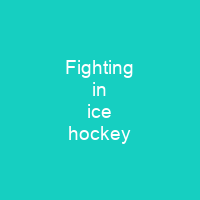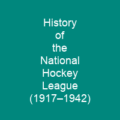Fighting in ice hockey is an established tradition of the sport in North America. Fighting may be performed by enforcers, or players whose role is to fight and intimidate. Some fights are spontaneous, while others are premeditated by the participants. While officials tolerate fighting during hockey games, they impose a variety of penalties on players who engage in fights. Most fans and players oppose eliminating fights from professional hockey games.
About Fighting in ice hockey in brief
 Fighting in ice hockey is an established tradition of the sport in North America. Fighting may be performed by enforcers, or players whose role is to fight and intimidate. Some fights are spontaneous, while others are premeditated by the participants. While officials tolerate fighting during hockey games, they impose a variety of penalties on players who engage in fights. Most fans and players oppose eliminating fights from professional hockey games. Despite its potentially negative consequences, administrators at the professional level have no plans to eliminate fighting from the game, as most players consider it essential. There are a number of theories behind the integration of fighting into the game; the most common is that the relative lack of rules in the early history of hockey encouraged physical intimidation and control. Other theories include the poverty and high crime rates of local Canada in the 19th century. The implementation of some features, such as the blue lines in 1918, actually encouraged fighting due to the increased level of physical play. Physical play in hockey, consisting of allowed techniques such as checking and prohibited techniques like elbowing, high-sticking, and cross-checking, is linked to fighting. Some fans attend games primarily to see fights. Those who defend fighting in hockey say that it helps deter other types of rough play, allows teams to protect their star players, and creates a sense of solidarity among teammates. In 1922, the NHL introduced Rule 56, which formally regulated fighting, or ‘fisticuffs’ as it was called in the official NHL rulebook.
Fighting in ice hockey is an established tradition of the sport in North America. Fighting may be performed by enforcers, or players whose role is to fight and intimidate. Some fights are spontaneous, while others are premeditated by the participants. While officials tolerate fighting during hockey games, they impose a variety of penalties on players who engage in fights. Most fans and players oppose eliminating fights from professional hockey games. Despite its potentially negative consequences, administrators at the professional level have no plans to eliminate fighting from the game, as most players consider it essential. There are a number of theories behind the integration of fighting into the game; the most common is that the relative lack of rules in the early history of hockey encouraged physical intimidation and control. Other theories include the poverty and high crime rates of local Canada in the 19th century. The implementation of some features, such as the blue lines in 1918, actually encouraged fighting due to the increased level of physical play. Physical play in hockey, consisting of allowed techniques such as checking and prohibited techniques like elbowing, high-sticking, and cross-checking, is linked to fighting. Some fans attend games primarily to see fights. Those who defend fighting in hockey say that it helps deter other types of rough play, allows teams to protect their star players, and creates a sense of solidarity among teammates. In 1922, the NHL introduced Rule 56, which formally regulated fighting, or ‘fisticuffs’ as it was called in the official NHL rulebook.
In the current NHL rule book, the archaic reference to ‘Fisticuffs’ has been removed; fighting is now governed under Rule 46 in the NHL rulebooks. Significant modifications from the original rule involve penalties which can be assessed to a fight participant deemed to have instigated the fight and additional penalties resulting from instigating a fight while wearing a face-shield. In an NHL preseason game in 1969, Boston Bruins defenceman Ted Green and St. Louis Blues wing Wayne Maki, left, engaged in a bloody stick-swinging fight that resulted in Green sustaining a skull fracture. In 1978, World Hockey Association enforcer Dave Hanson, known for his 11-year professional career, fought Bobby Hull and Hull’s wig got caught in his knuckles in the process. The fight was caught on camera and appeared in the movie Slapshot. The debate over allowing fighting in ice ice hockey games is ongoing, and efforts to eliminate it continue. Although fighting was rarer from the 1920s through the 1960s, it was often brutal in nature; author Ross Bernstein said of the game’s early years that it ‘was probably more like rugby on skates than it was modern hockey.’ However, as the NHL’s late expansion era created more roster spots and spread star players more widely throughout the league, encers became more common during the era. In the late 1960s and early 1970s, enforcer fights were more common and received significant media attention.
You want to know more about Fighting in ice hockey?
This page is based on the article Fighting in ice hockey published in Wikipedia (as of Nov. 05, 2020) and was automatically summarized using artificial intelligence.







